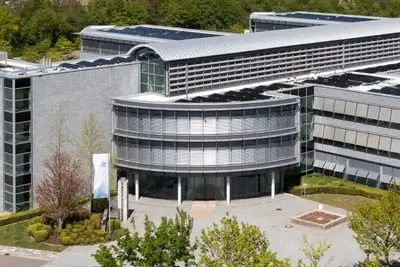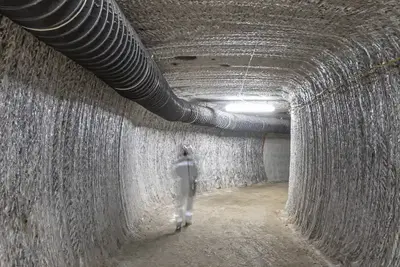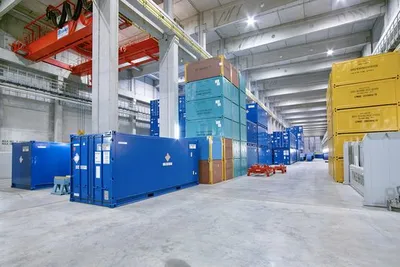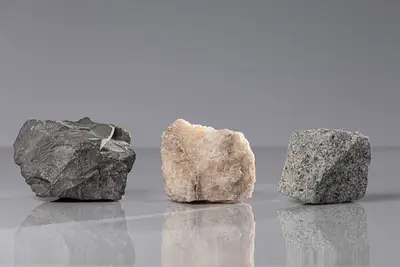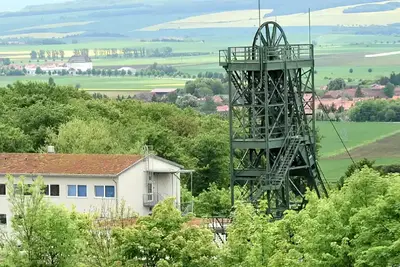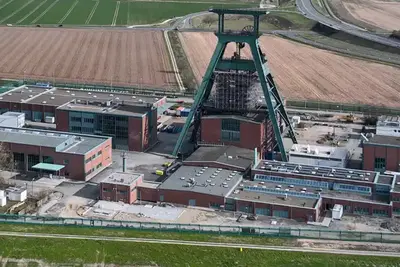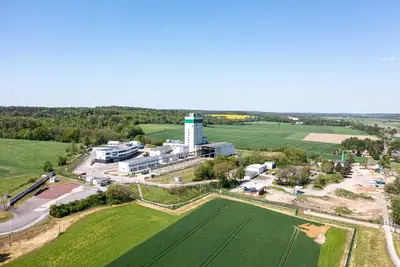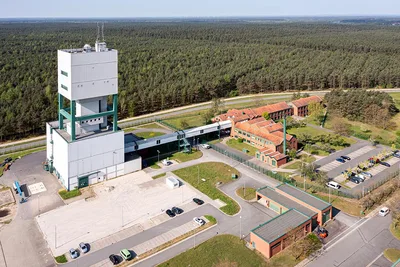Research
Research and development are important components for the successful implementation of the search for a repository site and the development of repository concepts for heat-generating high-level radioactive waste. The search for a suitable repository site in Germany is legally regulated by the Repository Site Selection Act (StandAG). For the implementation of the site selection procedure, we, as the project sponsor, identify relevant research and development needs and compile them in a research agenda. The agenda is divided into the following five research fields:
- Radiotoxic and chemotoxic behaviour of radioactive waste and its evolution
- Geoscientific questions
- Repository concept
- Preliminary safety investigations
- Social sciences
The prioritisation of research and development needs results from the degree of urgency (i.e. the point at which the respective results are needed in the multi-phase site selection procedure) as well as their importance for the procedure.
Research co-operations and projects of the Site Selection Division of the BGE (last revised: June 2020)
The Site Selection Division of the Bundesgesellschaft für Endlagerung mbH (BGE) initiates, supports, and carries out research projects and studies. The division exchanges information on the state and application of knowledge and technology in national and international cooperation projects. Furthermore, the site selection division participates in national and international research projects.
Participation of the site selection division in international cooperation
EURAD (European Joint Programme on Radioactive Waste Management, duration: June 2019 - May 2024)
EURAD is the European Union’s joint research programme on radioactive waste management and disposal. This is a Co-Funding European Joint Programme (EJP) under Horizon2020 (H2020-Euratom-1.2). The projects are financed by the participating partner organisations with a share of EU funding. More information on EURAD can be found here (external link).
The overall objectives of the joint research programme are:
- to assist Member States in the development and application of their national research and development programmes for the safe management of different types of radioactive waste
- to develop and consolidate knowledge regarding the safe operation of radioactive waste repositories
- to improve the transfer of knowledge between participating organisations and Member States.
Each EU Member State can send one project promoter (Waste Management Organisation – WMO), one expert organisation (Technical Support Organisation – TSO) and one or two Research Entities (RE) as programme partners. With a mandate from the Federal Ministry for the Environment, Nature Conservation and Nuclear Safety (BMU), the Federal Ministry for Economic Affairs and Energy (BMWi), and the Federal Ministry of Education and Research (BMBF), the BGE participates as the German waste management organisation in four EURAD projects.
- UMAN (Uncertainty Management multi-actor network) is a strategic study on the management of uncertainties in the disposal and management of radioactive waste. The aim of UMAN is to promote the understanding of different views and preferences on risks and how to deal with uncertainties among the various stakeholders (WMO, TSO, RE) together with representatives of civil society organisations (CSOs). In the framework of the study, the project partners and citizens’ representatives share their assessments and experiences through questionnaires, workshops, and forums. Finally, the results of the study should help to ensure the appropriate and comprehensible handling of uncertainties.
- The SoK (State of Knowledge) project is part of the EURAD Knowledge Management Programme. The aim is to pool existing global expertise in the field of radioactive waste disposal and management and make it available to the various national disposal programmes.
- GAS (Mechanistic understanding of gas transport in clay materials) aims to develop scientific methods for a better understanding of radionuclide transport via the gas phase in clay (geological barrier) and bentonite (geotechnical barrier) in order to assess the impact of gas transport on the safety of the barrier system.
- HITEC (Influence of temperature on clay-based material behaviour) is concerned with the development of scientific methods to better understand the influence of elevated temperature conditions on clay (geological barrier) and bentonite (geotechnical barrier). The focus is on the modelling of coupled thermal, hydraulic, and mechanical (THM) processes in order to assess how temperature increases affect the integrity of the barrier system.
IGD-TP (Implementing Geological Disposal of radioactive waste Technology Platform)
The IGD-TP is a research co-operation of European project promoters to promote the implementation of the national disposal programmes for the final disposal of high-level radioactive waste. The board was established in November 2009 on the initiative of the European Commission and European project promoters. The BGE has been a full member of the steering group since October 2019 and is involved in joint projects (e.g. on the effects of climate change). More information on the activities of the IGD-TP can be found here (external link).
DECOVALEX (Development of Coupled models and their Validation against Experiments)
In 1992, the international research collaboration consisting of organisations from the area of nuclear waste management (e.g. project promoters, regulatory authorities, research, and modelling teams) was started. The aim of DECOVALEX is to jointly address challenges related to coupled THM and THMC processes (modelling of coupled thermal, hydraulic, mechanical and chemical processes) in order to provide support for the development of numerical simulators for THM and THMC processes in geological systems, to investigate and implement suitable algorithms for THM and THMC modelling, to compare model calculations with results from field and laboratory tests, and to develop new experiments to support code and model development. More information on DECOVALEX can be found here (external link).
The BGE and the Freiberg University of Mining and Technology are participating in a long-term test of an emplacement route in the Mont Terri Rock Laboratory in Switzerland. The aim is the integrity assessment of the composite of geotechnical and geological barrier.
Salt Club, Clay Club und Crystalline Club der OECD/NEA
- Salt Club: Further development and exchange of scientific information on rock salt as host rock formation for deep geological repositories for high-level radioactive waste.
- Clay Club: Characterisation, understanding, and description of the suitability of clay rocks as host rock for a repository for high-level radioactive waste.
- Crystalline Club: Dealing with questions concerning crystalline rocks as host rock for a repository for high-level radioactive waste.
Clay Conference 2020
The eighth International Clay Conference is organised by ANDRA and was scheduled to take place in Nancy, France, from 8 to 11 June 2020. However, because of the current COVID-19 pandemic, the eighth International Clay Conference will take place in Nancy, France, from 14 to 17 June 2021.
During the conference, scientific findings (e.g. results from laboratory experiments and in situ tests in underground laboratories) on the use of clay as a geotechnical and geological barrier in the repository will be presented and discussed. The BGE is represented in the “Scientific Committee” of the Clay Conference 2021.
The 2022/2023 Clay Conference will be hosted by the BGE and the Federal Institute for Geosciences and Natural Resources (BGR) and will take place in the Hanover area.
Mont Terri Project
In accordance with the StandAG, the host rocks rock salt, clay rock, and crystalline rock are considered for the final disposal of high-level radioactive waste in Germany. The Mont Terri Rock Laboratory in Switzerland is located in Opalinus clay (Lower Middle Jurassic), which is also designated as a potential host rock formation in Germany. The BGE became an official partner in the Mont Terri project in July 2020. The high number of experiments in the rock laboratory offers the possibility of a good transferability of the results obtained to the Opalinus clay available in Germany. More information on the Mont Terri Rock Laboratory can be found here (external link).
Participation of the site selection division in national cooperation
“Numerical modelling” handbook
Initiated by the BGE, this project began in February 2019 with the participation of the Freiberg University of Mining and Technology, Gesellschaft für Anlagen- und Reaktorsicherheit (GRS) gGmbH Braunschweig, Gesellschaft für Anlagen- und Reaktorsicherheit (GRS) gGmbH Köln, Clausthal University of Technology, the Federal Institute for Geosciences and Natural Resources (BGR), the University of Stuttgart, Leibniz University Hannover, Institut für Gebirgsmechanik GmbH Leipzig, Forschungszentrum Jülich, the Helmholtz-Zentrum Dresden-Rossendorf and BGE Technology GmbH. The aim of the project is to create a handbook for numerical modelling within the framework of preliminary safety analyses. Publication of a first volume of the handbook – “Numerical modelling for safety considerations of repository systems: methodological approaches and current practice” – is expected at the end of 2022.
Current research projects relating to repository site selection
Effects of cyclical glaciation on salt structures as a potential repository site for high-level radioactive waste
Project aim: geodynamic model calculations are intended to allow assessment of the effects of cyclical glaciation on salt structures and the safety of a possible repository for high-level radioactive waste materials. Assuming realistic configurations (salt geometry, configuration of internal structures, etc.), the project is intended, among other things, to investigate the influence on the stress field and to identify possible preferred areas within the salt structures.
Thermal integrity of clay and clay stones – experiment and coupled THMC simulations
Project aim: statements regarding the integrity of clay and clay stones as barrier rock and barrier systems at various temperatures over 100°C.
Quantification and prediction of erosion processes
Project aim: an extensive quantification of erosion rates in Germany since the Miocene. Different analytical methods are used to describe erosion processes over various time scales.
Neotectonic activity in Central and Southern Germany
Project aim: this research project is intended to provide a quantitative and qualitative expansion of the database of active fault zones in Central and Southern Germany.
Search depth (consideration of subglacial erosion processes in the selection of a site for the final disposal of high-level radioactive waste)
Project aim: preparation of a forecast of the potential range and location-dependent depth effect of possible future glaciation in Germany. The forecast is aimed at areas that were identified as sub-areas in step 1 of phase I of the site selection procedure. Other key factors include the subglacial valleys with a depth of up to 550 m that emerged in the geological past, as well as regional geological conditions. Based on these findings, location-dependent depth levels are to be determined for the upper limit of a containment-providing rock zone for a repository for high-level radioactive waste.
OpenWorkFlow (synthesis platform for safety analyses as part of the site selection procedure)
Project aim: development of open source code adapted to the requirements of the site selection procedure in Germany for the purposes of conducting preliminary safety analyses and maintaining a safety case.
MATURITY (influence of thermal maturity on the coupled hydromechanical properties of low-permeability clay stones – field & laboratory scale)
Project aim: the MATURITY research project is intended to examine clay rock formations with different degrees of burial and compaction on the field & laboratory scale in order to, among other things, gain new insights into the transferability of clay rock properties to the preliminary safety analyses and the application of geoscientific weighing criteria.
PRECODE (investigation of the effects of mining activities at great depths on the integrity of crystalline rock in the context of the final disposal of high-level radioactive waste)
The project has three fundamental research objectives, which all relate to the evaluation of the suitability of crystalline rock as host rock for the final disposal of high-level radioactive waste:
- achieving an improved understanding of the formation and evaluation of excavation-disturbed zones in the crystalline rock
- testing methods for nature-identical cleft filling by fluid injection and thereby for the reduction of rock permeability
- developing a method for quantifying the dilatancy and fluid-pressure criterion in crystalline host rock.
AMPEDEK (atlas of mineralogical and petrophysical properties of German crystalline host rocks)
more information to come
ZuBeMErk (collation and evaluation of geophysical methods for surface exploration)
This research project began in November 2019 and is being conducted by the Federal Institute for Geosciences and Natural Resources (BGR). It ends in December 2022. For the potential host rocks according to the Repository Site Selection Act (crystalline rock, rock salt and clay rock), the project aims to collate the surface-physical, aerophysical and borehole-geophysical measurement methods according to the state of the art of technology and to make a comparative evaluation of their advantages and disadvantages for the exploration of shallow to intermediate-depth geological formations, as well as to describe the limits and uncertainties of their application. Based on this, the project will include a host rock-specific analysis and comparative evaluation of methods for surface geophysical site exploration.
GeoMePS (collation and evaluation of geoscientific methods and programmes for surface site exploration)
This research project began in November 2019 and is being conducted by the Federal Institute for Geosciences and Natural Resources (BGR). It ends in December 2022. For the potential host rocks according to the Repository Site Selection Act (crystalline rock, rock salt and clay rock), the project aims to collate the geoscientific methods (e.g. geological, geomechanical, hydrogeological and geochemical methods) according to the state of the art of technology and to make a comparative evaluation of their advantages and disadvantages for the exploration of shallow to intermediate-depth geological formations, as well as to describe the limits and uncertainties of their application. Based on this, the project will include a host rock-specific analysis and comparative evaluation of methods for surface exploration and recommendations for surface exploration programmes.
Exclusion criteria “seismic activity”, “active fault zones” and “groundwater age”
This research project in relation to the three exclusion criteria began in October 2019 and will be completed in July 2020 by the Federal Institute for Geosciences and Natural Resources (BGR).
The seismic activity exclusion criterion (section 22(2) number 4, Repository Site Selection Act) excludes areas in which seismic action could impair the safety of a repository. The map of earthquake zones in Germany (DIN 4149) served as the evaluation basis for the delimitation of areas at risk from earthquakes. This map was used as the basis for the preparation of the National Application Document DIN EN 1998-1/NA:2011-01. As the earthquake risk in Germany has subsequently been reassessed, the previous earthquake zoning will in future be replaced by the corresponding new maps in the draft version of DIN EN 1998-1/NA:2018-10. In the “work package seismic activity”, the data sets used for the respective DIN standard are to be collated and differences between the various DIN standards are to be worked out. In addition, the respective calculation methods and seismological parameters are to be compared, taking account of the subsurface geology. Based on this, an assessment is to be made of whether and how it is possible to transfer the classification of earthquake zones in DIN EN 1998‑1/NA:2011-01 to the new DIN EN 1998‑1/NA:2018-10.
The active fault zones exclusion criterion (section 22(2) number 2, Repository Site Selection Act) excludes rock zones that are a potential repository area, including a conservative safety distance, if the location has active fault zones that could have an adverse impact on the repository system and its barriers. It is for this reason that the “work package active fault zones” seeks to define the terms “fault”, “fault zone”, “basement fault”, “vertex fault” and “atectonic deformation structures”, which can influence barrier integrity. Furthermore, methods for determining the active period of faults are described and their limitations are discussed.
In accordance with section 22(2) number 6 of the Repository Site Selection Act, an area is not suitable for use as a repository site if young groundwater has been detected in the rock zones that are being considered as a containment-providing rock zone or emplacement area. For this reason, the “work package groundwater age” deals with the development of definitions and explanations of the terms “groundwater age” and “young groundwater” with regard to application as an exclusion criterion in the site selection procedure. Here, the focus is on host rock formations of crystalline rock, rock salt and clay rock.
“Volcanic activity” selection criterion – current state of research and definition of necessary safety distances
Launched in December 2019 with a predicted term of 18 months, this research project is being carried out by Professor Gerhard Jentzsch and Professor Ulrich Schreiber. In accordance with section 22(2) number 5 of the Repository Site Selection Act, an area is not suitable for use as a repository site if Quaternary volcanism is present or future volcanic activity is to be expected over the demonstration period of a million years. The research project is initially intended to identify locations in Germany at which Quaternary volcanism exists or future volcanic activity is to be expected. For areas in which future volcanism is to be expected, locations are also to be considered that were already volcanically active in the Tertiary period. For the identified locations, investigations are to be carried out to determine the eruption probability within the next million years and how this has been or will be influenced by spatial displacement. Based on this information, a necessary, individual safety margin is to be defined for the identified locations.
THEREDA (continuation and further development of the Thermodynamic Reference Database)
The Thermodynamic Reference Database (THEREDA) is a joint project with the participation of Gesellschaft für Anlagen- und Reaktorsicherheit (GRS) gGmbH Braunschweig, the Karlsruhe Institute of Technology – Institute for Nuclear Waste Disposal (KIT-INE), the Freiberg University of Mining and Technology (TUBAF), the Helmholtz-Zentrum Dresden-Rossendorf – Institute of Resource Ecology (HZDR-IRE), and the Paul Scherrer Institute (PSI). The aim is to create a comprehensive and internally consistent thermodynamic reference database for geochemical model calculations of aqueous electrolyte solutions. This reference database will be used for geochemical modelling of near- and far-field processes in various rock formations that are being discussed as potential repositories in Germany (crystalline rock, rock salt and clay rock). The data is to be used not only for long-term safety assessments in relation to the existing Konrad and Morsleben repository projects and the Asse II mine, but also for the siting regions or sites considered in the course of the site selection procedure. More information on THEREDA can be found here (external link). The BGE took over as project sponsor in April 2017.
The project for the continuation and further development of the Thermodynamic Reference Database began in January 2020 with a term of five years and, in addition to the maintenance and management of the database, includes corresponding further development in order to maintain the state of the art of science and technology.
The Thermodynamic Reference Database (THEREDA) is a joint project with the participation of Gesellschaft für Anlagen- und Reaktorsicherheit (GRS) gGmbH Braunschweig, the Karlsruhe Institute of Technology – Institute for Nuclear Waste Disposal (KIT-INE), the Freiberg University of Mining and Technology (TUBAF), the Helmholtz-Zentrum Dresden-Rossendorf – Institute of Resource Ecology (HZDR-IRE), and the Paul Scherrer Institute (PSI). The aim is to create a comprehensive and internally consistent thermodynamic reference database for geochemical model calculations of aqueous electrolyte solutions. This reference database will be used for geochemical modelling of near- and far-field processes in various rock formations that are being discussed as potential repositories in Germany (crystalline rock, rock salt and clay rock). The data is to be used not only for long-term safety assessments in relation to the existing Konrad and Morsleben repository projects and the Asse II mine, but also for the siting regions or sites considered in the course of the site selection procedure. More information on THEREDA can be found here (external link). The BGE took over as project sponsor in April 2017.
The project for the continuation and further development of the Thermodynamic Reference Database began in January 2020 with a term of five years and, in addition to the maintenance and management of the database, includes corresponding further development in order to maintain the state of the art of science and technology.
Thermal integrity of clay and clay stones – experiment and coupled THMC simulations
Launched in the first quarter of 2020 with a predicted term of 18 months, this research project is being carried out by Gesellschaft für Anlagen- und Reaktorsicherheit (GRS) gGmbH Köln and TU Darmstadt with a view to contributing to the development of a fundamental understanding of processes and systems relating to the safe disposal of radioactive waste. The aim is to gain a better understanding of the long-term behaviour of clay rocks in variable environmental conditions (e.g. temperature and chemistry). To achieve this aim, the project includes not only laboratory experiments but also the use of numerical models.
PIONIER (implementation and further development of material models for the simulation of THM-coupled processes within the framework of safety analytical investigations in clay rock and bentonite)
Launched in the second quarter of 2020 with a total project term of 60 months, this research project is being carried out by BGE Technology GmbH with a view to developing a better understanding of coupled thermal, hydraulic and mechanical processes (THM processes) for clay rock and bentonite. The project is conducted in close collaboration with the work of the BGE in the EURAD projects “GAS” and “HITEC”, so that findings from PIONIER are incorporated into “GAS” and “HITEC” and vice versa.
Completed research projects
RESUS I (development of a basis for representative preliminary safety analyses and for the safety-oriented consideration of sub-areas with particularly favourable geological conditions for the safe final disposal of high-level radioactive waste)
Launched in June 2018 and completed in November 2019, the RESUS I research project was carried out by Gesellschaft für Anlagen- und Reaktorsicherheit (GRS) gGmbH Braunschweig, the Federal Institute for Geosciences and Natural Resources (BGR) and BGE Technology GmbH. It served to develop a basis for representative preliminary safety analyses and the safety-oriented consideration of sub-areas with favourable geological conditions for the safe final disposal of heat-generating radioactive waste. The aim was to develop an approach that could achieve a high level of consistency between the results of preliminary safety analyses and safety-oriented geoscientific considerations. Based on detailed qualitative considerations and numerical analyses, recommendations were derived for 10 repository systems in host rocks consisting of crystalline rock, rock salt and clay rock with regard to how the individual results for the 11 geoscientific weighing criteria mentioned in the Repository Site Selection Act can be aggregated in a safety-oriented manner. The resulting summary report and the 10 accompanying individual reports are available to download from the GRS publication database (external link).
RESUS extension
Commissioned in December 2019 and running until August 2020, the RESUS extension was carried out by Gesellschaft für Anlagen- und Reaktorsicherheit (GRS) gGmbH Braunschweig, the Federal Institute for Geosciences and Natural Resources (BGR) and BGE Technology GmbH. It aimed to consolidate the methodological approach to demonstrating the integrity of repository containers in combination with geotechnical barriers. This includes the description of dependencies and influencing processes between repository container and geotechnical barrier (e.g. mechanical stresses) that are either beneficial for the demonstration of integrity or make it more difficult. The research also examined methodological approaches to describing the failure scenarios of the repository container (e.g. description of types of corrosion) and to the quantitative determination of premature container failure (and how this can be dealt with). Furthermore, the results of the RESUS project were to be visualised in three dimensions for all considered repository systems and to be used for knowledge dissemination within the BGE and in order to provide information to the general public. With regard to RESUS I and the results obtained in that project, the RESUS extension was intended to incorporate a diverse approach to the geoscientific weighing criteria. The aim of this was to investigate which indicators and geoscientific weighing criteria must be aggregated in order to identify areas that can be expected to offer favourable geological conditions for the safe final disposal of radioactive waste.
Forecast of volcanic activity
This research project was carried out by the Federal Institute for Geosciences and Natural Resources (BGR) and ran from November 2018 to June 2019. In accordance with section 22(2) number 5 of the Repository Site Selection Act, an area is not suitable for use as a repository site if Quaternary volcanism is present or future volcanic activity is to be expected over the demonstration period of a million years. In order to characterise such areas, the research project aimed to review existing proposals for the forecasting of volcanic activity and to create an overview of existing data on volcanic activity in Germany. Furthermore, the project established the state of scientific research into relationships between volcanic activity and other geodynamic processes and their causal connections. Based on this, proposals were drawn up for indicators of future volcanic activity and for the categorisation of forecasts of possible future volcanic activity in Germany. The results of the research project can be found here (external link).
This research project was carried out by the Federal Institute for Geosciences and Natural Resources (BGR) and ran from November 2018 to June 2019. In accordance with section 22(2) number 5 of the Repository Site Selection Act, an area is not suitable for use as a repository site if Quaternary volcanism is present or future volcanic activity is to be expected over the demonstration period of a million years. In order to characterise such areas, the research project aimed to review existing proposals for the forecasting of volcanic activity and to create an overview of existing data on volcanic activity in Germany. Furthermore, the project established the state of scientific research into relationships between volcanic activity and other geodynamic processes and their causal connections. Based on this, proposals were drawn up for indicators of future volcanic activity and for the categorisation of forecasts of possible future volcanic activity in Germany. The results of the research project can be found here (external link).
Forecast of uplift
This research project was carried out by the Federal Institute for Geosciences and Natural Resources (BGR) and ran from November 2018 to June 2019. In accordance with section 22(2) number 1 of the Repository Site Selection Act, an area is not suitable for use as a repository site if, as a result of extensive vertical movement, an average geogenic uplift of more than 1 mm per year is to be expected over a demonstration period of a million years. For this reason, the research project aimed to create an overview of existing and necessary data that is needed for a forecast of this kind. Furthermore, it summarised and explained the underlying geological and geodynamic processes for extensive vertical movement. Based on this, an assessment was made of the feasibility and requirements for forecasts of extensive vertical movement over a period of one million years, and a proposal was prepared for the possible categorisation of these forecasts. The results of the research project can be found here (external link).
Concept for the general approach to the application of geoscientific weighing criteria
This research project was carried out by the Federal Institute for Geosciences and Natural Resources (BGR) and ran from August 2018 to December 2019. In accordance with section 24(1) of the Repository Site Selection Act, the geoscientific weighing criteria are to be used to evaluate whether a favourable overall geological situation is present in an area. This is to be deduced in a transparent manner based on a safety-oriented consideration of the results in relation to all consideration criteria. In a first step, the BGR therefore developed a rough concept for the general approach to the application of the geoscientific weighing criteria. In a second step, this concept was put into concrete terms so that it was ready for implementation, including preparation for the data request by the BGE.

